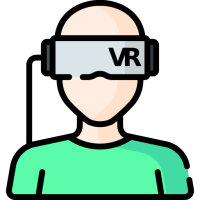Enhancing accessibility of Virtual reality, Augmented reality, and Mixed reality
Table of Contents

Introduction
- Virtual reality (VR), Augmented reality (AR), and Mixed reality (MR) are immersive technologies that have gained popularity in education application recently. The use of these technologies could render a real-world training environment which could be used to facilitate authentic learning.
- Examples of immersive technologies available are Meta Quest, Vive, and Google cardboard.
- The virtual or augmented environment and learning content could be customized to help cater for diverse learning and access needs of students.
- For example, virtual field trips could be produced to facilitate the learning experiences of students using wheelchairs when the field sites are really inaccessible to them or when alternative field sites are unavailable.
Examples of accessibility consideration and suggested solutions
- Make sure usual accessibility Application Programming Interface (APIs) are used in the development of the chosen software. Consider accessibility throughout the whole process of the design and production.
- Heavy headsets, hand tracking, and large handheld controllers with rigid buttons of some VR / AR / MR equipment may be barriers for some users such as students with mobility disability.
- Provide keyboard-only control for navigation and manipulation.
- Some users with visual impairment may encounter difficulty navigating in the virtual or augmented space.
- Provide audio descriptions to facilitate users with visual impairment to understand the environments or any text overlay on the screen.
- Allow users to magnify the content.
- Ensure sufficient colour contrast of the content.
- Some deaf or hard-of-hearing users may encounter difficulty immersing in the experience where it is highly dependent on sound effect or audio to render the experience.
- Provide transcripts and closed captioning for the audio elements of the experience.
- Provide adjustable volume and caption controls to allow flexibility.
- Robust Internet connections and high-performance computers may be required.
- Interface design and manipulation might be complicated.
- Provide tutorial of user interface operation for first-time users.
- Virtual reality experience may trigger motion sickness in some users.
- Limit the duration of the use each time.
- Arrange a trial for potential users to try to assess the possibility of motion sickness, especially for first-time users. For examples, some users may not have prior experience of immersing in virtual reality, and they may not be aware that they would experience motion sickness.
- Content that flashes more than three times per second may trigger unpleasant feelings, dizziness, nausea, or seizures in some people, such as people who are photosensitive.
- According to the WCAG Success Criterion 2.3.1, websites should not contain “anything that flashes more than three times in any one second period”.
- World Wide Web Consortium (W3C) guidelines on flash thresholds and a more precise technical formula are available for calculating general flash and red flash thresholds.
- The Trace Center at the University of Maryland has developed a Photosensitive Epilepsy Analysis Tool (PEAT) for measuring whether web or computer applications are likely to cause seizures.
Guidelines developed World Wide Web Consortium (W3C) Web Accessibility Initiative (WAI)
References
- Disability awareness and XR best practices. University of California, Berkeley.
- Accessibility for AR and VR (Google I/O ’18) (YouTube video). Google Developers.
- List of resources about accessible extended reality. XR Access Initiative.
- Discussion about the pros and cons, and examples of accessible virtual reality design in response to different disability and accessibility needs. University of Melbourne.
- The Accessibility Playbook for Emerging Technology Initiatives. The Partnership on Employment & Accessible Technology (PEAT).
- Accessibility Considerations for Augmented and Virtual Reality for the Classroom and Beyond. The Bureau of Internet Accessibility’s blog.
- Current and potential uses of AR/VR for equity and inclusion. The Information Technology & Innovation Foundation.
- Zallio, M., & Clarkson, P. J. (2022). Designing the Metaverse: A study on Inclusion, Diversity, Equity, Accessibility and Safety for digital immersive environments. Telematics and Informatics. https://doi.org/10.1016/j.tele.2022.101909 Ten principles for designing a good Metaverse that embraces inclusion, diversity, equity, accessibility, and safety.